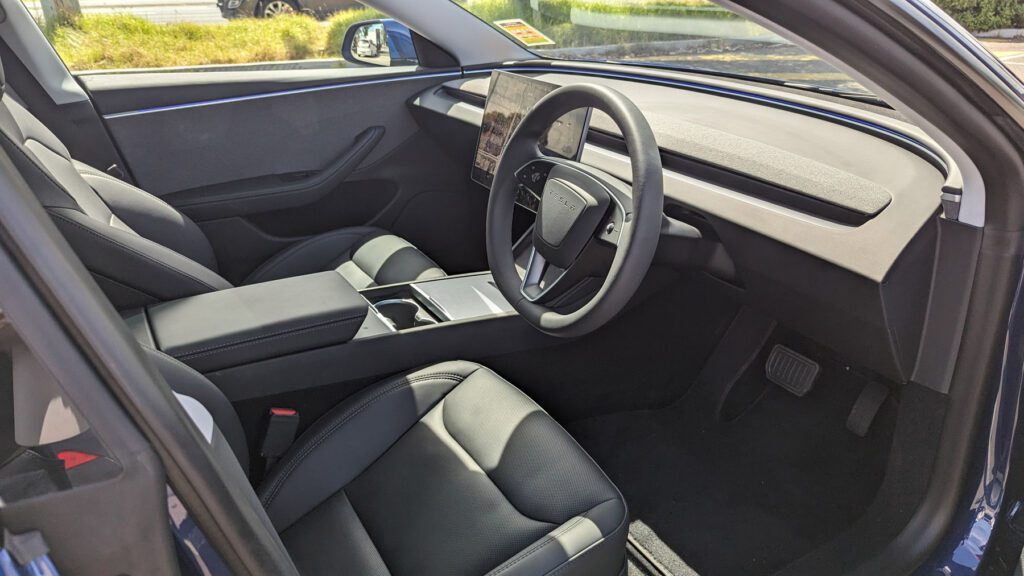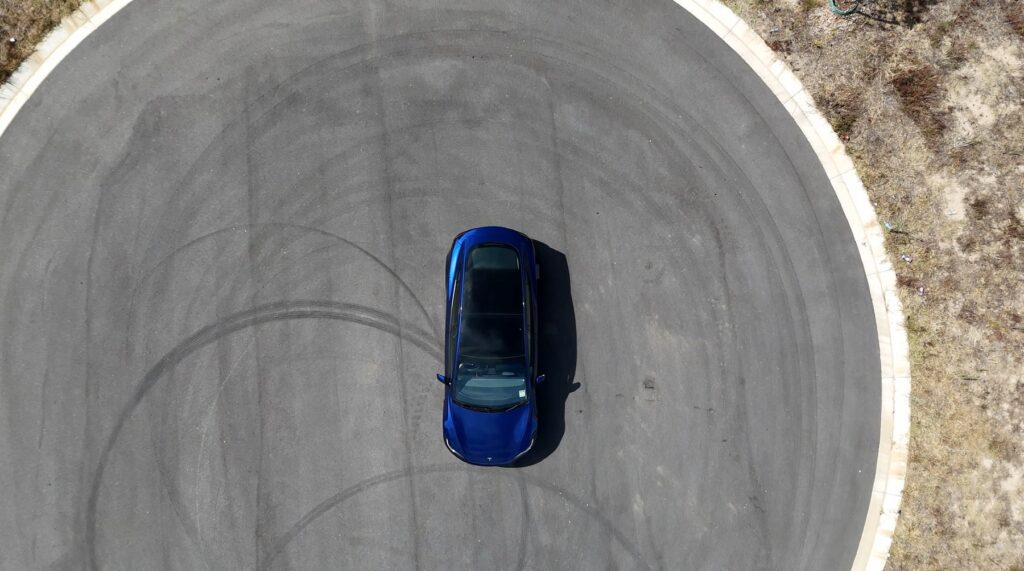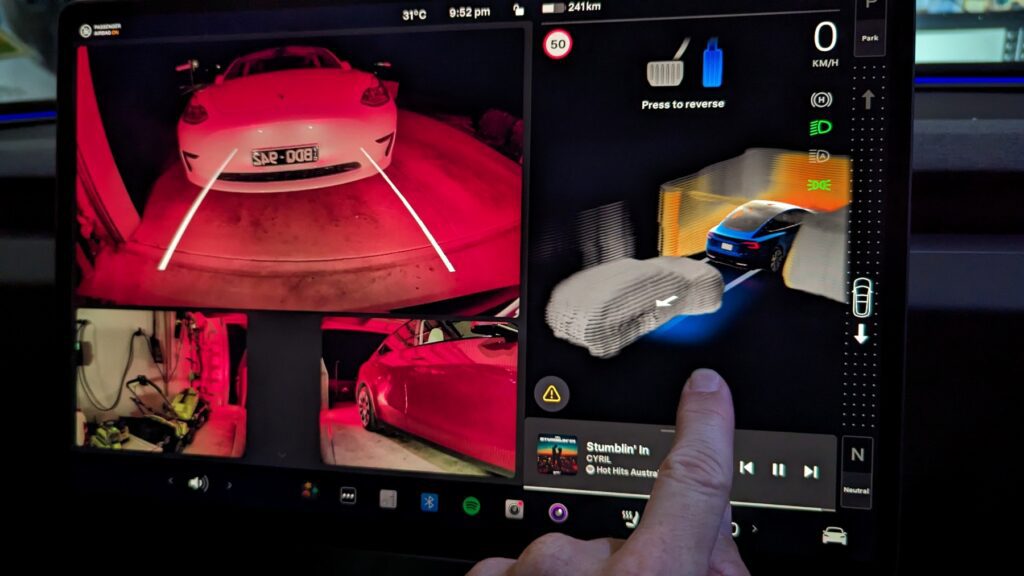It’s been the best part of 5 years since I took delivery of my Model 3 in 2019, and now I have the chance to spend a week behind the wheel of the refreshed Tesla Model 3. In that time, there have been some small changes, but this model is the big refresh many had been waiting for.
Having collected the car from Melbourne, I drove it 3.5hrs+ up the Hume Hwy to Wodonga and now have some initial impressions to share. These are not reflections from 5 minutes of driving, but rather a 50-minute hands-on video as I experienced the new features the new refreshed Model 3 (also known as Highland) has to offer in 2024.
This video above features my detailed first impressions of the new stalkless wheel, smart shift, high-fidelity park assist, matrix headlights and more, or you can read the text version below.
We’ll have a full review of the car soon, but for now, here are the early impressions on the biggest, most important changes on the Tesla Model 3.

Steering wheel (no stalks)
Consider this, every single car that you have sat in, has had stalks for gear selection, indicating, lights, wipers and more. All of that got a complete rethink with the refreshed Model 3 and much like the deletion of a driver’s instrument cluster, Tesla is not scared of change, they have an idea and execute like no other company I’ve seen.
Removing stalks is only possible thanks to some other key decisions Tesla made a number of years ago. The decision to go with a camera-only computer vision approach to monitoring the environment around the vehicle has now led Tesla to a position where they can introduce a technology called Smart Shift that automatically selects the right gear for you, based on the environment around you.
There is of course a manual override on the right edge of the screen, and buttons are available as a backup on the roof, adjacent to the hazard button, but the idea here is that you’ll never need them.
The remaining functions have been translated to buttons on the steering wheel, something Tesla has famously avoided, performing most of the common driver functions using just two multi-function scroll wheel buttons. The addition of buttons on the wheel first started in the refreshed Model S and X and has continued into the Cybertruck and now the refreshed Model 3, leaving just the Model Y with stalks.
Having experienced this myself, I’m happy to confirm the adjustment period is small. Within 20-30 minutes, my brain started to update its muscle memory of using the stalks to indicate and rewire to the new button configuration. It took a little longer to commit the button order to memory, right on top, left on the bottom. By the time I got home, I’d indicated dozens of times successfully and realised how easy it is to adapt, if this is your full-time vehicle.
if you are switching between a model 3 with this configuration and another vehicle with regular stalks (including Model Y in this), then it is likely to be a daily challenge to traverse the if, this, then that lookup before indicating.
There was probably an opportunity to drop one stalk, for headlights, wipers and gear selection, but having 1 stalk would not only have looked strange and unbalanced, it also would have missed the biggest opportunity. By deleting both stalks, Tesla achieves elegance in design and saves costs and complexity.
Ultimately I’m glad there’s a company in the world that pushes vehicle design forward, even if it is jarring to some users. What I would love them to consider is a move to have the right indicator on the right side of the wheel and the left on the left. This would make the use of the buttons more logical and natural. I’m not sure on the dataset that explains why the top direction is right and the bottom left. Will other automakers follow, I strongly doubt it, but if Tesla does believe stalkless is a better driving experience, the Model Y needs to move to match.


Smart Shift
With the door closed, pressure on the driver’s seat and the seatbelt on, Smart Shift is enabled. Just press your foot on the brake and the car uses computer vision to Automatically select the correct direction of travel. So far, it’s batting 1,000, I’ve never had it mess up, but this will be a key focus area for my time with the car, to really thoroughly test this across a range of environments.
From here you get a visual indication by way of an on-screen arrow to ensure you know what to expect when you accelerate. Even after exiting and entering the vehicle just a few times I really got to appreciate just how simple this process is.
- Walk up to the car, open the door (it unlocks from the phone in your pocket)
- Get in the car
- Put your seatbelt on
- Put your foot on the brake and release
- Press the accelerator to drive away.
When we compare this with the startup process for a legacy ICE car, the most extreme example being a manual transmission, it’s night and day.
- Unlock the car with key/keyfob etc
- Get in the car
- Put your seatbelt on
- Put your foot on the brake
- Push the clutch in
- Select Neutral
- Turn the key or press the Push button to start.
- Wait for the car to warm up
- Select first gear
- Release the hand brake
- Release the clutch while pressing the accelerator
This is more than double the number of steps to just get the car to move, every, single, time.
Having now used Smart Shift 15 times, I have only seen it select the wrong direction once (shown at the end of the video above). This occasion was in the drive-thru bottle shop entrance that was one-way. There was certainly nothing behind the car, and there was the shop ahead, but context matters and in this context, it got the suggested gear wrong.


High-fidelity park assist
I had seen the videos and covered the news of the launch of high-fidelity park assist, but had not been able to try it, given our cars have ultrasonic sensors. Now with a non-USS car, I can try it out and I have to say I love it.
Again leveraging Tesla’s work in computer vision, it builds a virtual environment around the car in the visualisation to allow you to see what surrounds the vehicle.
As you park this car, it now leverages its new HW4 camera array to detect the environment around you and visualises that in a new way to drivers. The visuals on-screen now show a 3D representation of the world, and as you approach objects, they turn yellow, orange and eventually red, letting you know where you need to stop.
The fidelity of the environment is amazing, and surprisingly accurate for a system that regularly displays the wrong vehicle graphics beside you.
So far, Tesla has only shipped the feature on vehicles that don’t have ultrasonic sensors, which use computer vision to measure distance. Having now used this, I think it’s definitely superior to the legacy parking visuals and Tesla should ship this to all vehicles, at least as an option.
I noticed the feature only works at speeds below 10km/hr and does work in Drive and Reverse. When experimenting with this at home, I noticed the roller door opening in front of the vehicle wasn’t animated as it opened, it was shown as closed, then open, but when opened, it immediately displayed the Model Y sitting in the garage.
What’s impressive here is Tesla’s ability to render, with accuracy, things in the virtual space, until now we’d really only seen items beside the vehicle or below (road markings).

Not a good move to suggest the indicators be separated. Imagine the wheel is half turned and now you need to indicate quickly again for the opposite turn. If it’s initially a left turn then the right arrow is now under your left thumb, but you’ve trained yourself to use the right thumb for a right indicator. It will automatically press the left indicator, compared to reaching across yourself. I’ve successfully made the transition in the Highland but every so often I have to be conscious of where the indicator for the next quick turn is – on top or underneath.
Are you referring to smart shift in both of these sentences?
“Just press your foot on the brake and the car uses computer vision to Automatically select the correct direction of travel. So far, it’s batting 1,000, I’ve never had it mess up, ”
“Having now used Smart Shift 15 times, I have only seen it select the wrong direction once”
Initially I had no errors, then had 1, the number is now about 1 in 50 shifts.